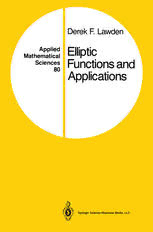
Elliptic Functions and Applications PDF
350 Pages·1989·4.238 MB·English
Most books are stored in the elastic cloud where traffic is expensive. For this reason, we have a limit on daily download.
Preview Elliptic Functions and Applications
Description:
The subject matter of this book formed the substance of a mathematical se am which was worked by many of the great mathematicians of the last century. The mining metaphor is here very appropriate, for the analytical tools perfected by Cauchy permitted the mathematical argument to penetra te to unprecedented depths over a restricted region of its domain and enabled mathematicians like Abel, Jacobi, and Weierstrass to uncover a treasurehouse of results whose variety, aesthetic appeal, and capacity for arousing our astonishment have not since been equaled by research in any other area. But the circumstance that this theory can be applied to solve problems arising in many departments of science and engineering graces the topic with an additional aura and provides a powerful argument for including it in university courses for students who are expected to use mathematics as a tool for technological investigations in later life. Unfortunately, since the status of university staff is almost wholly determined by their effectiveness as research workers rather than as teachers, the content of undergraduate courses tends to reflect those academic research topics which are currently popular and bears little relationship to the future needs of students who are themselves not destined to become university teachers. Thus, having been comprehensively explored in the last century and being undoubtedly difficult .
See more
The list of books you might like
Most books are stored in the elastic cloud where traffic is expensive. For this reason, we have a limit on daily download.
